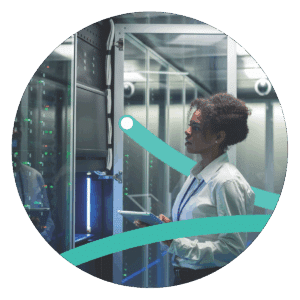Innovation: the accelerator for data centres and growth zones
Power connections are still a leading risk factor for worldwide data centre projects. In this blog post, Group Sales Director, David Swadling, explains how independent power network operators can accelerate data centre connections, innovating and reimagining their way around the issues holding your projects back.
 I won’t spend long rehashing what the data centre industry already knows: it’s hard to get your data centre project connected to worldwide electricity grids. Despite – and partly because of – the UK’s attractiveness as a data centre destination, we have a substantial connections queue. New projects face waits of years, potential investments can become delayed or stalled, and the resulting log-jam imperils the government’s AI Growth Zone ambitions.
I won’t spend long rehashing what the data centre industry already knows: it’s hard to get your data centre project connected to worldwide electricity grids. Despite – and partly because of – the UK’s attractiveness as a data centre destination, we have a substantial connections queue. New projects face waits of years, potential investments can become delayed or stalled, and the resulting log-jam imperils the government’s AI Growth Zone ambitions.
The causes are nuanced, but the root is that the ramping up of data centre demand coincides with the need to modernise and redesign grids for renewable power and net zero. At the same time, grid operators’ skills, resources and cash are limited. Ofgem, NESO (the National Energy System Operator) and the wider industry are working with some success to address the connections queue, but for major data centre investors and operators the simple problem remains: connections to the transmission network come slowly, threatening growth and making the UK a less compelling destination.
So, what else can we do to unblock power connections, accelerate data centre delivery, and keep the UK’s thriving digital economy on track?
Energy parks – a route to faster, better grid connections
Let’s start by returning to the connections queue and remembering that it comprises not just data centre and other large-demand ventures, but generation and storage projects too. Within the UK, NESO is embarked on a connections reform programme that has created quotas for the various generation technologies seen as necessary to reach the Clean Power 2030 Action Plan and beyond. As succinctly as possible, this means that generation projects that are funded, have planning permission, and fit within the quota, are likely to get transmission connections first.
For this and many other reasons, there are huge advantages to data centre operators and renewable energy generators going into partnership. Co-locating projects gives major demand customers the chance to ‘piggy back’ on the accelerated grid connection available to the right generation project. More than that, it provides a source of power resilience and or cheaper energy to the data centre, provides a major customer for the generator, and allows both parties to benefit from buying and selling energy ‘behind the meter’, avoiding use-of-system charges.
That’s exactly the philosophy behind energy parks such as Future Point Manchester, a new joint development from Eclipse Power Optimise and Carlton Power. With a 1.4 gigawatt (GW) grid connection scheduled for 2028 that requires no upstream reinforcement, is adjacent to the 884MW Carrington CCGT power plant, and is planning to include 500 megawatts (MW) of low-carbon generation on site, the development has been conceived as a home to one of Europe’s largest data centres – and as a potential AI Growth Zone.
Private networks – specialist power solutions for your project
 Energy Parks offer developers a route to faster power connections and shorter project delivery timelines, but they come with additional challenges. Data centre customers aren’t renewable energy developers, and vice versa. No matter the benefits to both of co-habiting, and sharing a large power connection to the transmission network, doing so raises the potential need for a transmission licence – an unrealistic hurdle for businesses who aren’t in the power transmission space.
Energy Parks offer developers a route to faster power connections and shorter project delivery timelines, but they come with additional challenges. Data centre customers aren’t renewable energy developers, and vice versa. No matter the benefits to both of co-habiting, and sharing a large power connection to the transmission network, doing so raises the potential need for a transmission licence – an unrealistic hurdle for businesses who aren’t in the power transmission space.
It’s in this area that independent power distribution specialists like Eclipse Power deliver the necessary mix of expertise and innovation to unblock major projects. We can design, build and manage the necessary power infrastructure to connect co-located generation and demand users to each other, and to the transmission network. In the case of Future Point Manchester, we’re designing and adopting a private network, with all the necessary infrastructure to give data centre clients the connection voltage they need – essentially offering a turnkey power solution.
This model represents a huge benefit to data centre developers, as it removes a substantial CAPEX cost, further lowering investment and project barriers. It also supports a scalable approach where connections can be added and upgraded to support substantial load growth over time.
Better outcomes
I’ve focused on the idea of energy parks for a reason – at present, they represent one of the most viable ways to accelerate hyperscale data centre projects in the UK. Yet similar innovations in the distribution space speed up distributed and edge computing ventures, and again reduce their CAPEX costs.
This agility is the hallmark of the UK’s partially deregulated electricity distribution sector, where licensed and un-licensed independent distribution network operators and independent connection providers can work in partnership to disrupt and innovate, achieving quicker, better outcomes for data centres than possible with the incumbent distribution network operators (DNOs) and transmission operators (TOs).
That’s why it’s increasingly essential for hyperscalers and other data centre developers to look for innovative partnerships and providers in the power sector, who can help find ways to lower energy barriers and unlock major projects. It’s an essential route to meeting your own growth and investment targets in the face of a global power problem. And it’s key to capitalising on the financial and planning incentives available in the UK, as it seeks to leverage its strong digital proposition and deliver on its AI ambitions.
Your pre-2030 connection journey could be simpler than you think. Talk to us about your power connection headaches.
Get in touch
- enquiries@eclipsepower.co.uk
- 01234 486487
- Contact Us
- Follow us on Linked In
